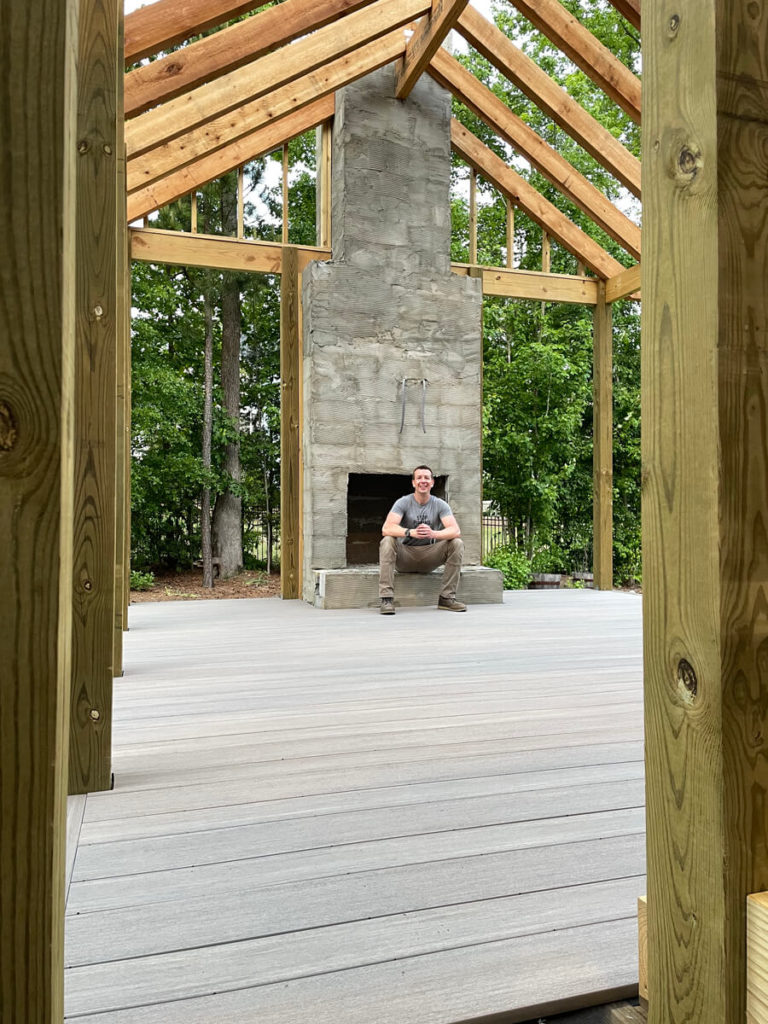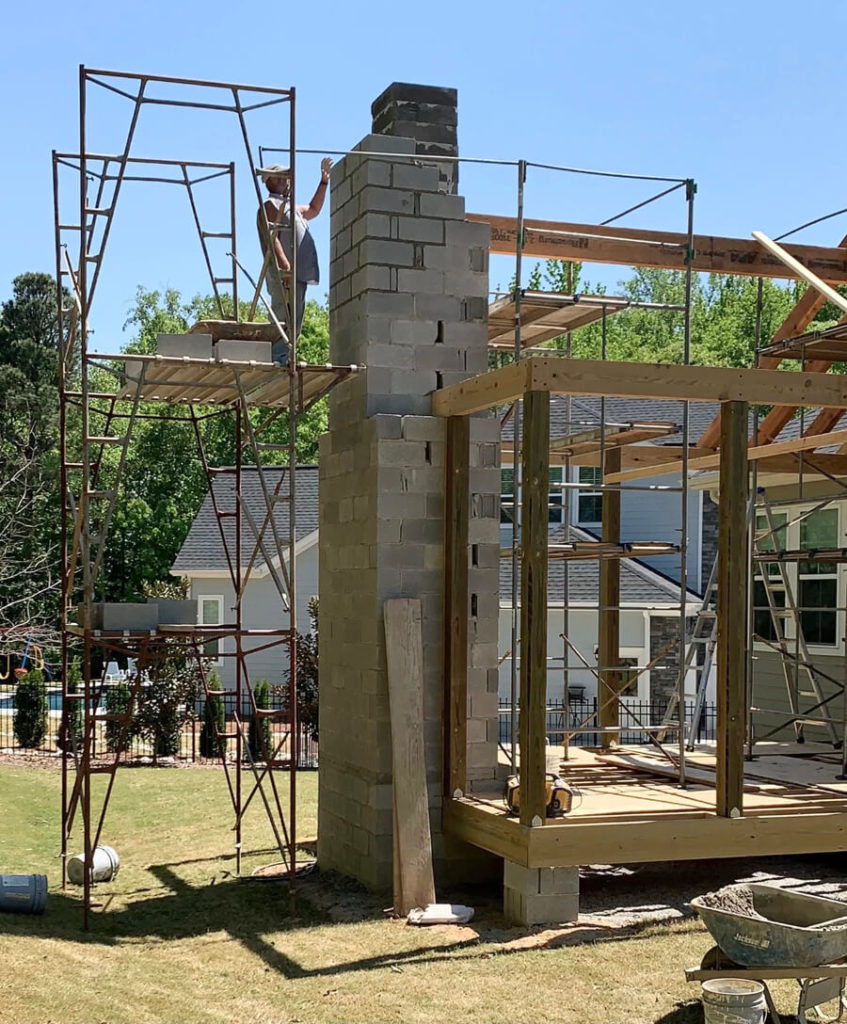Home renovations can cost anywhere from a couple hundred dollars to a couple hundred thousand dollars and there are some important financial questions to consider when planning a large project for your home. This post is sponsored by Discover Personal Loans.
I wanted to write this article because my in-progress screened-in porch project (its current state is shown in the picture below!) is a large financial commitment and I had to think carefully about how much money to put into it and how to pay for it.

For many of us, our homes are not only where we spend much of our time, they are also typically one of our most important financial assets. They tend to appreciate over time but the most return is often achieved by investing some amount of money in their upkeep and upgrading. Upkeep is needed to fix issues that would eventually cause major structural damage and unnecessary expenses. Upgrading allows you to make your home a more functional space you love to be in and keep it current so that if you had to sell, someone else would love it more, too! This article addresses some important financial issues homeowners face when planning for a home renovation.
How much money should I put into my home?
This is one of the first questions you have to ask yourself, and it will require a little homework. The homework here is to understand what the typical homes in your neighborhood look like and what they sell for.
While adding living space may add a lot of value, you should still survey the neighborhood. Adding more space to a home that is smaller than the neighborhood average will typically be more valuable than adding more living space to a home that is already the largest in the neighborhood.
For example, the porch of your dreams might cost $80k, but would the investment result in a space that’s far and above what’s typical for other homes in your price range? You may only see a fraction of that $80k expense back if you were to sell and may want to consider a more modest budget so you can spend on other upgrades around your home to improve it overall.
All of these considerations are important to help keep you from “over-improving” your home. Over-improving can lead to negative equity. As an example, imagine a scenario where you buy a home for $300k, invest $100k in renovations and then have to sell a few years later but can only get $360k for the home. You’ve invested $100k and only see $60k of it in your selling price.
Of course living in a home you absolutely love because of the renovations you’ve done has value in itself! But, think realistically about how long you will be in the home. If it is very likely that you will be there for the long run, a splurge here or there might be worth it!
How do I finance a home renovation?
With a few exceptions, I tend to complete my home renovation projects using the “pay-as-you-go” approach. A long time ago, Jenni and I started a savings account with the main purpose of funding our home renovations. We have a fairly fixed budget and we are able to make a consistent deposit into that account each month. We plan our short-term and long-term renovations based on the actual and projected cash flow into and out of that account, never wanting to drain it to zero. For most of our home renovations this has worked really well, and I suggest it as a first approach. The renovation feels that much sweeter when you’ve saved hard for it and it’s paid for in full on the day that it’s completed!
For home renovation projects that need to happen faster than pay-as-you-go can allow for, bridge gaps or overages you didn’t initially account for in the pay-as-you-go fund, or for a project that is necessarily larger than your fund, personal loans can be an excellent tool.
Fixed rates and flexible repayment terms may allow you to create a budget that includes your personal loan repayment. Here is a simple trick to make sure you can really afford the loan: Find out the monthly payment for your projected loan amount using an online calculator and compare it to how much of your discretionary income you typically have left over to save at the end of the month. If the projected payment is less, then a personal loan might be a good choice for you!
There are a lot of options out there, but I recommend Discover Personal Loans. Discover lets you design and customize a personal loan around your project with same-day decisions in most cases, no origination fees and flexible repayment terms. Their loan amounts range from $2,500 to $35,000 and the funds are sent as soon as the day after the loan is approved!
While credit cards have their utility, I don’t typically recommend using them as a tool to finance large projects. The rates can be high and if you only pay the minimum balance, it can take a really long time to pay off the renovation project. Using home equity to finance a large renovation project can also be a smart approach for really large, pricey projects. But there are so many variables that are unique to each homeowners’ situation that it is hard to know if it makes sense unless you consult with a financial professional.
How do I maximize every dollar?
When it comes to financing, an additional way to maximize your budget is to watch out for fees. Some lenders charge origination fees, a one-time charge to get the loan that’s calculated as a percentage of the loan and is taken out of the amount you receive. For example, if your lender charged a 5% origination fee on a $18,000 loan, that’s $900 less going to your project.
Luckily, Discover Personal Loans doesn’t charge fees as long as you make your monthly payments on time. Plus, with a fixed rate that never goes up and a choice of repayment terms, you can budget for one set regular monthly payment.
And when it comes to doing the work for your project? I bet you can guess my number one recommendation — DIY! But that is not always feasible for everyone or every project so l will give you some additional thoughts as well.
A large renovation project can come with hundreds of hours of labor. The popular term “sweat equity” comes from the fact that you can literally save thousands if not tens of thousands of dollars on a large project by doing it yourself.
However, before you embark on this you have to do a self-assessment:
- How long would it take me realistically to complete this? Is the answer years instead of weeks?
- Am I able to find the resources I need to make sure the project is done correctly? And do I need permits and to meet code? Often times, you do.
- Is my time more valuable somewhere else? What tradeoffs am I willing to make to spend the hours doing this project?
If you love to DIY around the house but the previous list still has you questioning whether you want to tackle a large project you may want to consider a hybrid model where you hire out part of the work while doing a lot of the finishing work yourself. A great example of this would be an unfinished attic space. You might want to hire out the framing, electrical and drywall and then do all of the finishing work after the space is created. In my current porch project, I knew I did not want to do any masonry work, so I found an excellent mason to create the fireplace and chimney for me!

For some large projects it may make the most sense for you to just hire out the whole thing. If this is the case, you should bring in multiple contractors to give quotes and to interview. I say interview because you should feel like you are in charge, that you are the boss hiring for this project and not the other way around.
Ask contractor candidates about their whole construction history, their portfolio, their personal recommendations and some hard questions like “what is the worst mistake you’ve ever made on a job?” or “how do you handle clients that think you are not meeting their quality expectations?” Do as much research as possible beforehand so they can tell that you know your stuff and they won’t be able to cut corners on your job. There are many reputable contractors out there and you want to make sure that you are hiring one of the good ones!
You need to get multiple quotes because ranges can be huge. It is expected that contractors will make money doing the work (it is their living), but there is no reason you should pay 50% more than a typical rate just because the contractor thinks they are the only one bidding your project. Let them all know that you are getting quotes from multiple contractors. When they provide the quotes ask them how they markup materials and to break out materials costs from labor. The more information you can squeeze during this process the better!
I hope you found the information in this article valuable. Large renovations can be financially complex and the more you plan ahead the better off you will be in the end!
I am not a professional financial planner or real estate agent so all of the content in this article must be read with that in mind. These are things I’ve just picked up over the years when thinking about my own renovations. Consult a professional before you make decisions about investing in your home!
Great insight Philip!
Great insight and points to consider. Yes, pay-as-you-go is wise advice and should be the preferred method. HELOCs offer great flexibility at a low interest rate. The details about hiring a contractor are so important in choosing a qualified professional. Thank you for sharing your home improvement projects @philiporflop as well as teaching and guiding us through challenging decisions. Can’t wait to see what’s next!
Great advice! Both on financing and interviewing builders.
I’m telling clients often about how to interview builders. I liked your line of questioning abd plan on adding some of those questions myself.